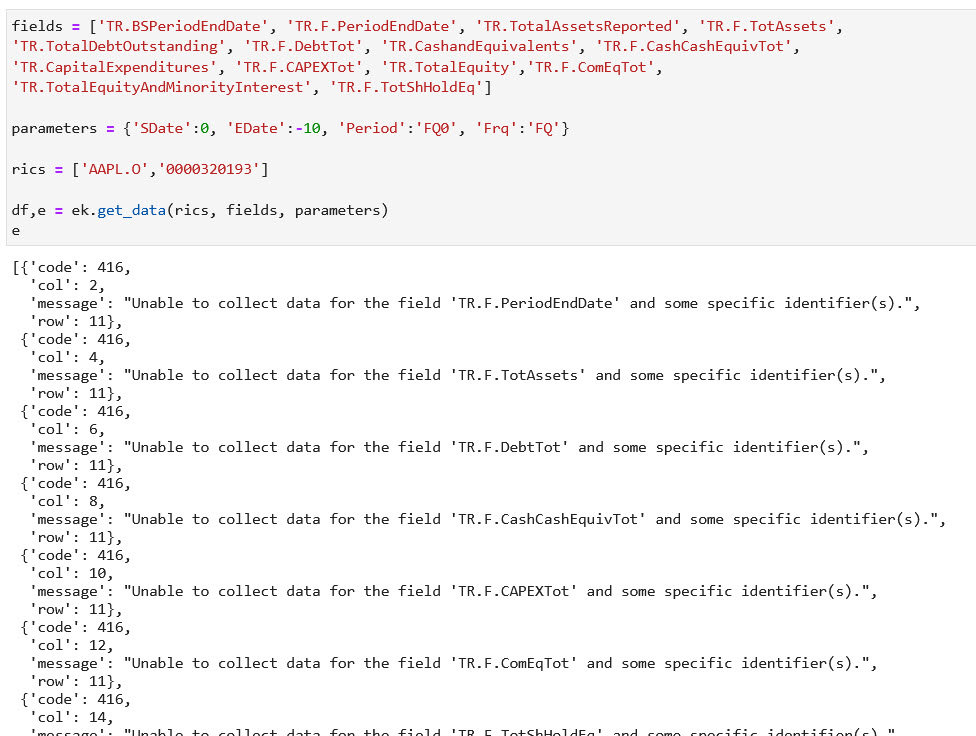“My initial query (I was testing CIK versus ticker. The CIK is pulling in some null results compared to ticker for some datatypes.):
df, err = ek.get_data(
instruments = ['AAPL.O','0000320193'],
fields = [
'TR.CIKNUMBER', 'TR.CommonName', 'TR.F.PeriodEndDate(SDate=0,EDate=-19,Period=FQ0,Frq=FQ)', 'TR.F.TotAssets(SDate=0,EDate=-19,Period=FQ0,Frq=FQ)',
'TR.F.DebtTot(SDate=0,EDate=-19,Period=FQ0,Frq=FQ)', 'TR.F.MktCap(SDate=0,EDate=-19,Period=FQ0,Frq=FQ)', 'TR.F.CashCashEquivTot(SDate=0,EDate=-19,Period=FQ0,Frq=FQ)',
'TR.F.EV(SDate=0,EDate=-19,Period=FQ0,Frq=FQ)', 'TR.F.CAPEXTot(SDate=0,EDate=-19,Period=FQ0,Frq=FQ)', 'TR.EBITDA(SDate=0,EDate=-19,Period=FQ0,Frq=FQ)', 'TR.EBIT(SDate=0,EDate=-19,Period=FQ0,Frq=FQ)'
]
)
display(df)
=======================================================================
I tried some more datatypes and also converted CIK to RIC. I think CIK works with datatypes of TR.xxx while RIC works with both TR.xxx and TR.F.xxx most of the time.
While the figures are mostly equivalent, for some quarters, the numbers do differ. Should I be using one rather than the other (TR.F. vs TR.) for RIC/CIK? Which one would be data from SEC filings?
'TR.BSPeriodEndDate(SDate=0,EDate=-10,Period=FQ0,Frq=FQ)', 'TR.F.PeriodEndDate(SDate=0,EDate=-10,Period=FQ0,Frq=FQ)',
'TR.TotalAssetsReported(SDate=0,EDate=-10,Period=FQ0,Frq=FQ)', 'TR.F.TotAssets(SDate=0,EDate=-10,Period=FQ0,Frq=FQ)',
'TR.TotalDebtOutstanding(SDate=0,EDate=-10,Period=FQ0,Frq=FQ)', 'TR.F.DebtTot(SDate=0,EDate=-10,Period=FQ0,Frq=FQ)',
'TR.CashandEquivalents(SDate=0,EDate=-10,Period=FQ0,Frq=FQ)', 'TR.F.CashCashEquivTot(SDate=0,EDate=-10,Period=FQ0,Frq=FQ)',
'TR.CapitalExpenditures(SDate=0,EDate=-10,Period=FQ0,Frq=FQ)', 'TR.F.CAPEXTot(SDate=0,EDate=-10,Period=FQ0,Frq=FQ)',
'TR.TotalEquity(SDate=0,EDate=-10,Period=FQ0,Frq=FQ)','TR.F.ComEqTot(SDate=0,EDate=-10,Period=FQ0,Frq=FQ)',
'TR.TotalEquityAndMinorityInterest(SDate=0,EDate=-10,Period=FQ0,Frq=FQ)', 'TR.F.TotShHoldEq(SDate=0,EDate=-10,Period=FQ0,Frq=FQ)',




